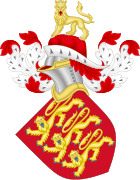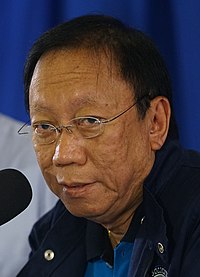Quo warranto
| Prerogative writs |
|---|
| Administrative law |
|---|
| General principles |
| Grounds forjudicial review |
|
Administrative law in common law jurisdictions |
|
Administrative law in civil law jurisdictions |
| Related topics |
In the English-Americancommon law,quo warranto(Medieval Latinfor "by what warrant?" ) is aprerogative writissued by acourtwhich orders someone to show what authority they have for exercising some right, power, orfranchisethey claim to hold. The writ ofquo warrantostill exists in theUnited States,although it is uncommon, but it has been abolished inEnglandandWales.Quo warrantois also used, with slightly different effect, in thePhilippines.
Early history
[edit]With the spread of royal justice in the 12th and 13th centuries, private franchises and liberties were increasingly called upon to uphold the king's peace: to act against "malefactors and peace breakers, so that it may appear that you are a lover of our peace".[1]From 1218 onwards,[2]royalEyresalso began using the oldwritofquo warranto– a court order to show proof of authority, as for example (literally) "By what warrant are you the sheriff?" – to investigate the origins of such franchises.[3]An inquest of 1255 began examining such liberties nationwide;[4]and the same enquiry was taken up again by KingEdward I of Englandin 1278, when he decreed in theStatute of Gloucesterthat "We must find out what is ours, and due to us, and others what is theirs, and due to them".[5]
From one point of view this can be seen as an attempt to investigate and recover royal lands, rights, and franchises inEngland,[6]in particular those lost during the reign of his father,King Henry III of England.[7][8]From another, it was less of an attack on franchises as a clarification of them: inHilda Johnstone's words, "Edward's aim, it is clear, was from the first not abolition but definition".[5]
| Statute of Quo Warranto | |
|---|---|
| Act of Parliament | |
 | |
| Long title | Statutum de Quo Warranto |
| Citation | 18 Edw. 1 (Ruffhead: 18 Edw. 1. Stat. 2) |
| Dates | |
| Repealed | 15 August 1879 |
| Other legislation | |
| Repealed by | Civil Procedure Acts Repeal Act 1879 |
Status: Repealed | |
| Statutum de Quo Warranto Novum | |
|---|---|
| Act of Parliament | |
 | |
| Long title | Statutum de Quo Warranto Novum |
| Citation | 18 Edw. 1 (Ruffhead: 18 Edw. 1. Stat. 3) |
| Dates | |
| Repealed | 15 August 1879 |
| Other legislation | |
| Repealed by | Civil Procedure Acts Repeal Act 1879 |
Status: Repealed | |
A similar ambiguity surrounds the role of the justices that, from 1278 to 1294, Edward dispatched throughout theKingdom of Englandto inquire "by what warrant" English lords claimed their liberties and exercised jurisdiction, including the right to hold a court and collect its profits. Some of the justices demanded written proof in the form of charters, others accepted a plea of "immemorial tenure";[9]and resistance[10]and the unrecorded nature of many grants meant that eventually, by theStatute of Quo Warranto(18 Edw. 1) (1290), the principle was generally accepted that those rights peacefully exercised since 1189 – the beginning of the reign of Richard I, which is the legal definition in England of the phrase "time immemorial"[6][11]– were legitimate.[12]
Publication
[edit]Thequo warrantopleas from the reigns of Edward I,Edward IIandEdward IIIwere published by theRecord Commissionin 1818.[13]
Later developments
[edit]The most famous historical instance ofquo warrantowas the action taken against theCorporation of LondonbyCharles IIin 1683.[14]TheKing's Benchadjudged the charter and franchises of the City of London to be forfeited to the Crown, though this judgment was reversed by theLondon, Quo Warranto Judgment Reversed Act 1689shortly after theGlorious Revolution.
But the remodelling of the City of London was only part of a wider remodelling of some forty chartered parliamentary boroughs by the Crown[15]– a policy taken up again in 1688 byJames II,when some thirty-five new charters were issued after quo warranto produced the surrender of the old ones.[16]This Quo Warranto remodelling or 'dissolution' of the parliamentary corporations gave point to the claim byWilliam IIIthat "our expedition is intended for no other design but to have a free and lawful parliament assembled", and underpinned the charge in theBill of Rightsthat James had been "violating the freedom of election by members to serve in parliament".[17]
Modernquo warranto
[edit]Whilequo warrantoremains in use in the United States, the Philippines, and other jurisdictions, in some jurisdictions that have enactedjudicial reviewstatutes, the prerogative writ ofquo warrantohas been abolished.
Australia
[edit]Quo warrantowrits have been abolished in theAustralian statesofNew South Wales(as of the Supreme Court Act 1970)[18]andQueensland(as of the Judicial Review Act 1991).[19]
England and Wales
[edit]The writ ofquo warrantoand its replacement, the information in the nature of aquo warrantoare either obsolete or have been abolished. Section 30 of theSenior Courts Act 1981grants to theHigh Courtthe power to issue an injunction to restrain persons from acting in offices in which they are not entitled to act and to declare the office vacant if necessary.
United States
[edit]Quo warrantocould be brought against a corporation when it misuses its franchise. In 1890, theSupreme Court of Ohiowrote:
The corporation has received vitality from the state. It continues during its existence to be the creature of the state, must live subservient to its laws, and has such powers and franchises as those laws have bestowed upon it, and none others. As the state was not bound to create it in the first place, it is not bound to maintain it after having done so, if it violates the laws or public policy of the state, or misuses its franchises to oppress the citizens thereof.[20]
In 1876, the Pennsylvania senate passed a resolution instructing the Attorney General to beginquo warrantoproceedings torevoke the charterof theBaltimore, Philadelphia and New York Railroad.[21]
In the modernUnited States,quo warrantousually arises in acivilcase as aplaintiff's claim (and thus a "cause of action"instead of a writ) that some governmental or corporate official was not validly elected to that office or is wrongfully exercising powers beyond (orultra vires) those authorized by statute or by the corporation's charter.
InNew York State,the former writ ofquo warrantohas beencodified.Per Executive Law § 63-b, only the Attorney General, at his or her discretion, "may maintain an action, upon his own information or upon the complaint of a private person, against a person who usurps, intrudes into, or unlawfully holds or exercises within the state a franchise or a public office, civil or military, or an office in a domestic corporation."[22]
Philippines
[edit]
Aquo warrantopetition was, before the appointment ofJose CalidaasSolicitor General,a very seldom used Philippineextraordinary writ.Its name derives from the Latin questionquo warranto,which means "by what authority?"[note 1][23]In its early days, during theAmerican colonial period,quo warrantowas mostly used to challenge ademocratic election,that is, to make the claim that the person who is holding an office is ausurper,and that someone else deserves the office, e.g., due toelectoral fraudorineligibility.[24]Indeed, this is the only way the term is used inlaw professorErnesto C. Salao's[note 2]widely cited 858-pagebookThe 1987 Constitution of the Republic of the Philippines(2001ed.).[25]
It has come to be understood that it can be used in extraordinary cases to unseat judicial appointees, and impeachable officials, not only to challenge elections. Some, such as Ranhilio Aquino,[note 3]argue this due to the fact that the President and Vice President were explicitly enumerated as vulnerable toquo warrantoby the Supreme Courtsitting asthePresidential Electoral Tribunal,[26][27]and, unlike many other constitutions, Article 11 of the1987 Constitutiondoes not exclusively grant the power of impeachment to Congress.[26]
Quo warrantoof non-elected appointees
[edit]Quo warrantopetitions, when successful, do not "remove" someone from office—they declare the very appointment itselfnull and voidab initio,meaning that the office was never legally held as it has been declared to have been assumed underfalse pretenses.[28]This is precisely what happened in the highly controversialquo warrantopetition against Maria Lourdes Sereno.Sereno had served on the Supreme Court of the Philippines asde factoChief Justice of the Philippinesfrom 2012 to 2018, and as a regularAssociate Justicesince August 2010, when she was appointed byPresidentBenigno Aquino III.Instead of removing Sereno from office by the mechanism of impeachment, Callida chose to use what one justice called this "road less travelled" ofquo warranto.
Corporate franchisequo warranto
[edit]Quo warrantowas also used, once again by Calida, to challenge the continued operation of ABS-CBN after the expiration of its Congressional franchise. This use ofquo warrantoin a dispute overlicensurewas as novel as it was literal: it strips away the traditions surrounding the use ofquo warrantoand refocusesquo warrantoon the meaning of its name, asking by what legal authority does ABS-CBN continue to operate. However, the expiration of the franchise and later actions by theNational Telecommunications Commissionmade Calida'squo warrantopetitionmoot.
See also
[edit]References
[edit]- ^Henry III, 1237, inHelen CamLaw-finders and Law-makers(London 1962), pp. 38–39.
- ^Helen Cam,Law-finders and Law-makers(London 1962), p. 39.
- ^S. H. Steinberg (ed.),A New Dictionary of British History(London 1963) p. 299.
- ^Helen Cam,Law-finders and Law-makers(London 1962) pp. 39–40.
- ^abJ. R. Tanner (ed.),The Cambridge Medieval History, Vol VII(Cambridge, 1932), p. 394.
- ^abClanchyFrom Memory to Written Record,p. 3.
- ^Harris, Nicholas;Charles Purton Cooper(1831).Public Records.p. 74.
- ^Carpenter, David A.(1996).The Reign of Henry III.p. 88.ISBN978-1-85285-137-8.
- ^Helen Cam,Law-finders and Law-makers(London, 1962), p. 41.
- ^Clanchy,From Memory to Written Record,p. 7.
- ^ClanchyFrom Memory to Written Record,p. 152.
- ^S. H. Steinberg (ed.),A New Dictionary of British History(London, 1963), p. 299.
- ^Illingworth 1818.
- ^Shortt, John (1888),Informations (criminal and quo warranto) mandamus and prohibition,American law series, C. H. Edson and company, p. 137.
- ^J. H. Plumb,The Growth of Political Stability in England(London 1986) pp. 55-6.
- ^M. Ashley,The Glorious Revolution(London, 1966), p. 112.
- ^M. Ashley,The Glorious Revolution(London, 1966) pp. 205–207.
- ^Sn 12 Quo WarrantoSupreme Court Act 1970,New South Wales Consolidated Acts.
- ^Sn 42 Abolition of quo warranto,Judicial Review Act 1991,Queensland Consolidated Acts.
- ^Lewis, Lawrence; Hamilton, Adelbert; Merrill, John Houston; McKinney, William Mark; Kerr, James Manford; Thomson, John Crawford (1890).The American and English Railroad Cases: A Collection of All the Railroad Cases in the Courts of Last Resort in America and England.Edward Thompson Company. pp. 332–334.
- ^House, Pennsylvania General Assembly; Representatives, Pennsylvania General Assembly House of (1876).Journal of the... of the... House of Representatives of the Commonwealth of Pennsylvania.George Helmbold. p. 917.
- ^"New York Consolidated Laws, Executive Law - EXC § 63-b. Action by attorney-general against usurper of office or franchise".FindLaw.1 Jan 2021.
- ^John Van de Kamp(1990).Quo warranto: resolution of disputes -- right to public office(PDF).Sacramento:California Attorney General's Office.p. 1.
- ^Mack, William; Hale, William Benjamin (1920).Corpus Juris: Being a Complete and Systematic Statement of the Whole Body of the Law as Embodied in and Developed by All Reported Decisions.Vol. 20. New York: American Law Book Company. p. 210.
- ^Ernesto C. Salao (2001).The 1987 Constitution of the Republic of the Philippines(2001 ed.). Quezon City: Rex Book Store. pp. xxvii, 714, 717.ISBN978-971-23-3252-4.
- ^abAquino, Ranhilio (2018-04-13)."Much ado about quo warranto".Manila Standard.Retrieved2020-06-09.
- ^2010 Rules of Presidential Electoral Tribunal(ResolutionAM10-04-29-SC, Rule 16). Supreme Court of the Philippines. May 4, 2010. p. 12.
- ^Cabato, Regine (2018-06-20)."Lawyers: Supreme Court cases with tiebreaking Sereno vote can be questioned".CNN Philippines.Archived fromthe originalon 2020-06-09.Retrieved2020-06-09.
Notes
[edit]- ^Sometimes rendered as "by whose authority?", althoughquoliterally means "where" or "why".
- ^As of January 2018,associate deanof thePolytechnic University of the Philippines College of Law.
- ^As of 2011,deanof theSan Beda UniversityCollege of Law. SeeRex G. Rico (2011-11-24)."Value of a non-lawyer's opinion on purely legal issues".Philippine Daily Inquirer.Retrieved2020-06-09.
Sources
[edit]Edition of proceedings
[edit]- Illingworth, William,ed. (1818).Placita de Quo Warranto temporibus Edw. I. II. & III. in Curia Receptae Scaccarii Westm. Asservata.Record Commission.London.
Bibliography
[edit]- Clanchy, M. T.(1993).From Memory to Written Record: England 1066–1307(Second ed.). Oxford: Blackwell.ISBN978-0-631-16857-7.
- Prestwich, Michael(1997) [1988].Edward I(revised ed.). New Haven: Yale University Press.ISBN0-300-07209-0.)
- Prestwich, Michael(1980).The Three Edwards: War and State in England 1272–1377.London: Weidenfeld & Nicolson.ISBN0-297-77730-0.
- Sutherland, Donald W. (1963).Quo Warranto Proceedings in the Reign of Edward I, 1278–1294.Oxford: Clarendon Press.
External links
[edit]- .Encyclopædia Britannica(11th ed.). 1911.
- .New International Encyclopedia.1905.
